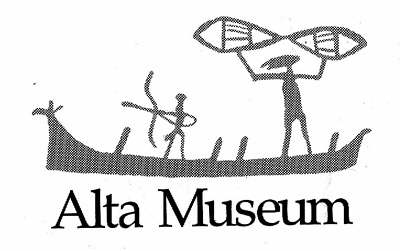.

In the entrance to the Alta Museum, you find a glass box on a desk which invites attention. If you are interested in the 'origin of life' then here is a possible answer: you see a unique specimen of a stromatolite. I was unfortunately not well equipped for this kind of photography, so the images obtained are not sharp enough.

.
This was obviously a well studied sample; some microscopic images were also shown. These fossil remains of early, one-celled organisms were, at least 1½ billion years old! Isn't that exciting?
Very wisely, UNESCO has decided to add Alta Fjord and its vicinity to the World Heritage Sites. The following image is a reproduction from a pamphlet obtained at the entrance.

©Alta Museum. Fotograf Stein A. Bernholt.
.
These ancient rock carvings, also known as petroglyphs, show many engravings and beautiful paintings. They formed part of an open air museum annex to the main Alta Museum, and bear all the signs of an ancient human settlement in this far northerly place in prehistoric times between 4200 to 500 B.C. When you walk around those large rocks via a small path and descend towards the sea nearby, you instantaneously get a picture of our ancestors' life style; a marvelous sense that takes you back to a time that can only be measured in millennia. This feeling is not easy to describe, it must be experienced at the site.
Here are the prehistoric rock drawings found in Alta, Norway:

Carvings illustrate mainly boats, fishermen and fish... .

... and herd and reindeers with long antlers.
.

Some images of the carvings are used as an emblem in North Cape or on the ticket of the Alta Museum, even more surprisingly, as a greeting from Earth to the Universe! .


It is very interesting that the paintings remain in excellent condition despite the harsh climate, excessive lichen growth and other disturbances throughout so many years. .


It seems to me that some recent cleaning work took place at the site to minimise destruction which may probably be caused by lichens. Attentive work and conservation of such ancient sites are necessary if we want to keep our heritage for future generations. .

I put a mark, a black arrow, to indicate a drawing of an animal which was carved but not painted. No doubt, such fine details can only be visible after a cleaning process
Once at home, I identified several web sites about rock carvings including those at Alta. It's interesting to know that the ultimate rock carving ever made by a human being has been figured in a gold plaque attached to Pioneer 10 and Pioneer 11 which are travelling into outer space. It carries a message, greetings, typical of petroglyphs all over the world. ~~~~
My wish to cross the Arctic Circle became a reality once again in Rovaniemi during my journey to Helsinki. The place called Napapiiri was crowded by a curious public from all over the world.

My wife posing at 200 meters near the Polar Circle at 66° 32' 35".
.

And then, this is it; the big day, D-day for me. Here we are on the Arctic Circle at Napapiiri, Rovaniemi, in June 16th, 2000. Look at that globe, our small world!

To regard Arctic regions only as cold barren places, would be unjust. In a scenic landscape, we saw plenty of small flowers, even tulips, but they all were late in flowering. It is however true that the main vegetation of Arctic and supra-Arctic regions is dominated by lichens and shrubs; an Arctic tundra, with its own charm. And don't forget to add sporadic animals to this scene, especially some reindeers and enthusiast adventurers called Homo sapiens sapiens. ~~~~ In a beautiful park in Helsinki, a drunk gentleman told us that those majestic linden trees, which were in full blossom at this time of the year, were planted by Russians about 100 years ago. Unfortunately, I couldn't check the validity of his words; they may be not correct. These trees, Tilia platyphyllos, were apparently quite old ones. Suddenly my attention was focused on the trees mainly because of the large, irregular lumps on their trunks. No doubt, these irregularities were plant tumours which I had been seeking for a long time. Here below, I show images of these trees with tumours for people who, like me, want to know about that particular entity and who want to be a silent witness of such a universal, biological phenomenon. The causes of tumours in living organisms in general, the way they happen, their biological-structural effects on the host organisms, economic impact of the disease are all of great interest. We may come to these subjects in my next articles.
.

.

.

.

~~~~
Our next port of call was Stockholm, capital of Sweden. It was a lovely, sunny day. We first visited the City Hall which proudly and monumentally stands as a national and international symbol of scientific excellence, thanks to Alfred Nobel's foresight. Its columns were the pillars of wisdom.




